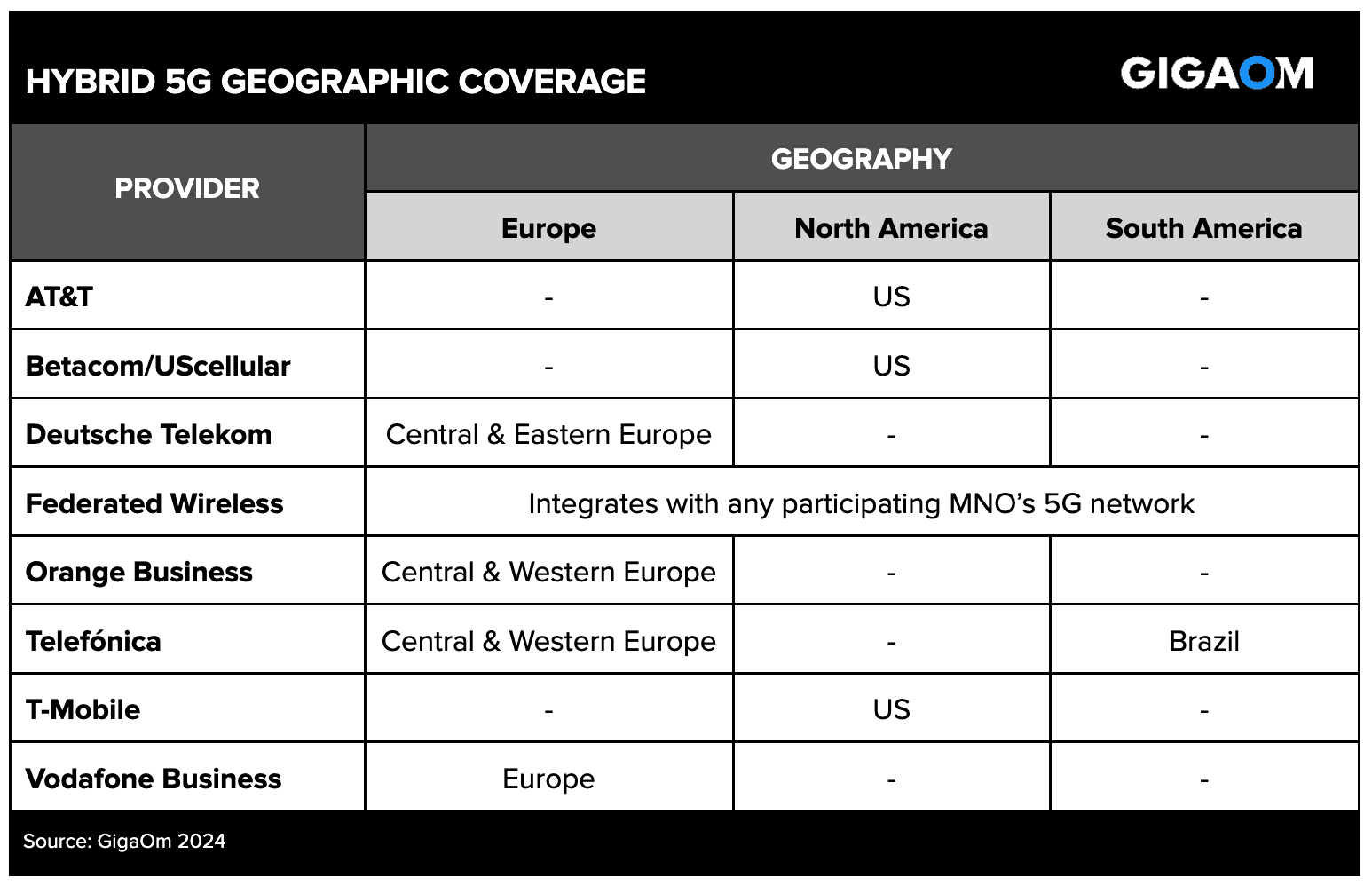Table of Contents
- Executive Summary
- Market Categories and Deployment Types
- Decision Criteria Comparison
- GigaOm Radar
- Solution Insights
- Analyst’s Outlook
- Methodology
- About Ivan McPhee
- About GigaOm
- Copyright
1. Executive Summary
Hybrid 5G is an emerging network model that integrates both public and private 5G infrastructure. It allows organizations to deploy a private 5G network—or use a dedicated network slice of a public 5G network—for business-critical tasks to ensure low latency, optimized performance, and secure data transfer, while relying on public 5G infrastructure for more general tasks such as internet access and email. The combination of private and public 5G merges the scalability of public 5G networks with the security and performance of private 5G networks to satisfy the demands of specific customer applications and edge use cases.
Offering more control, enhanced security, and customized services compared to public 5G networks, private 5G is deployed in a growing number of facilities in the agricultural, defense and military, education, entertainment and sports, energy and utilities, healthcare, manufacturing, mining, retail, and transportation sectors. However, building private 5G networks from scratch is capital intensive and time consuming, with numerous challenges to overcome in terms of regulatory hurdles, licensing requirements, keeping up with rapidly evolving technologies, and recruiting and training specialized staff or relying on third-party service providers for support.
As a result, leading mobile network operators (MNOs)—including Deutsche Telekom, Orange Business, T-Mobile, and Vodafone—are partnering with enterprises to deliver hybrid 5G services meeting both current and future needs, with flexible deployment models filling the gap between dedicated, standalone private 5G networks and a fully virtualized network slice using public 5G infrastructure. In some cases, a private 5G network caters to specific use cases requiring ultra-low latency or rigorous security, while the public 5G network is used for all other requirements. In other instances, a dedicated network slice of the public 5G network integrates with the public network, ensuring seamless connectivity between devices inside the private network and those outside of it. Federated Wireless, on the other hand, has developed a neutral host architecture that works with multiple MNO networks, extending 5G service from multiple carriers into areas covered by private 5G networks.
It should be noted, however, that as an emerging technology, hybrid 5G solutions using licensed spectrum are available only within the geographic boundaries of the operator’s 5G public network (see Figure 1) and may initially be restricted to certain countries within the geography. Unlicensed spectrum, on the other hand, can be deployed anywhere and is not restricted to the operator’s footprint. Moreover, while operators may be developing hybrid 5G solutions in other countries or geographies, information pertaining to those solutions is not currently available. Furthermore, since regulatory agencies in many countries are still in the process of issuing 5G licenses and allocating spectrum, we expect the availability of hybrid 5G solutions to ramp up considerably in the next 12 to 36 months.
Figure 1. Geographic Coverage of Hybrid 5G Solutions
Considering the ever-increasing bandwidth, performance, and reliability demands of new, evolving use cases, the appeal and advantages of hybrid 5G networks are rapidly becoming more apparent across diverse sectors. As a result, leading mobile and fixed network operators are leveraging their relationships with network equipment vendors and leading cloud hyperscalers to develop flexible hybrid 5G solutions, with more wireless companies expected to provide hybrid 5G solutions in the future.
This is our first year evaluating the hybrid 5G space in the context of our Key Criteria and Radar reports. This GigaOm Radar report examines nine of the top hybrid 5G solutions in the market and compares offerings against the capabilities (table stakes, key features, and emerging features) and non-functional requirements (business criteria) outlined in the companion Key Criteria report. Together, these reports provide an overview of the category and its underlying technology, identify leading hybrid 5G offerings, and help decision-makers evaluate these solutions so they can make a more informed investment decision.
GIGAOM KEY CRITERIA AND RADAR REPORTS
The GigaOm Key Criteria report provides a detailed decision framework for IT and executive leadership assessing enterprise technologies. Each report defines relevant functional and non-functional aspects of solutions in a sector. The Key Criteria report informs the GigaOm Radar report, which provides a forward-looking assessment of vendor solutions in the sector.
